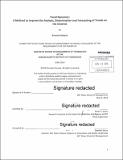Trend dynamics : a method to improve the analysis, dissemination and forecasting of trends on the Internet
Author(s)
Strazza, Ernesto (Strazza Silva)
DownloadFull printable version (16.02Mb)
Other Contributors
Sloan School of Management.
Advisor
Peter A. Gloor.
Terms of use
Metadata
Show full item recordAbstract
This thesis provides a new perspective in trend analysis with the acknowledgement of individuals as carriers of trends and susceptible to influence simultaneously by a trend's perceived significance and by external effects (media, peers, society, etc.), which reshape individuals' trend preferences according to the type, direction, and strength of the stimuli received. Internet trends are considered as elements that carry knowledge that can provoke a shift in actors' behavior, altering their preferences to a new direction because they affect individuals' values and beliefs. If trends can change individuals' behavior and conduct, and later, their preference progression, trends also have the capability to accumulate information on what individuals care about, how their inclinations have changed and towards which new interests they are moving. If products and services have specific aspects that trigger selections of the same products and services by unrelated individuals, this will denote the presence of a unique feature or set of features that acts as a gateway of contact. This work proposes the elaboration of actors' and products' networks to be implemented within Internet systems, to improve current technology that captures and displays users' preference evolution and potential trend formations; since people leave traces of their historic behavior, enabling the observance of relations between their current social and product networks, the newly entered and the ones left behind. Each consecutive preferred product contains information of a new assessment of individuals, expressing further necessities, values, aspirations, and desires. If several individuals point to the same products and services, those similar products and services will be the connection element increasing individuals' level of correlation in relation to the amount of products matched. Moreover, if a trend triggers a new preference, the progression of preferences will contain the sequence of drives and external effects or rather, the record of cultural elements that were involved; information that could be used to forecast the probability of positive reactions towards the trend by other similar individuals who were not following it. Because a trend travels through followers, each follower will be part of a virtual network outlined and materialized by the products and services chosen by them. This thesis suggest the idea that a trend is evidenced through the spontaneous sequence of detection, routing and preference from differentiated actors towards the same product or service, because that concordance shows the existence of a broadly valued aspect and a common-connector element that provokes preference agreements among isolated individuals despite their dissimilarities, allowing Web-based companies to develop and observe social-products networks to understand which trends and features have the potential to be successful, which phenomena are affecting preferences and which remaining users are susceptible to increase the diffusion of the trend..
Description
Thesis: S.M. in Management of Technology, Massachusetts Institute of Technology, Sloan School of Management, 2014. 43 Cataloged from PDF version of thesis. Includes bibliographical references (pages 74-76).
Date issued
2014Department
Sloan School of ManagementPublisher
Massachusetts Institute of Technology
Keywords
Sloan School of Management.